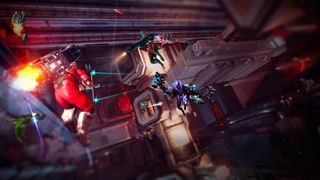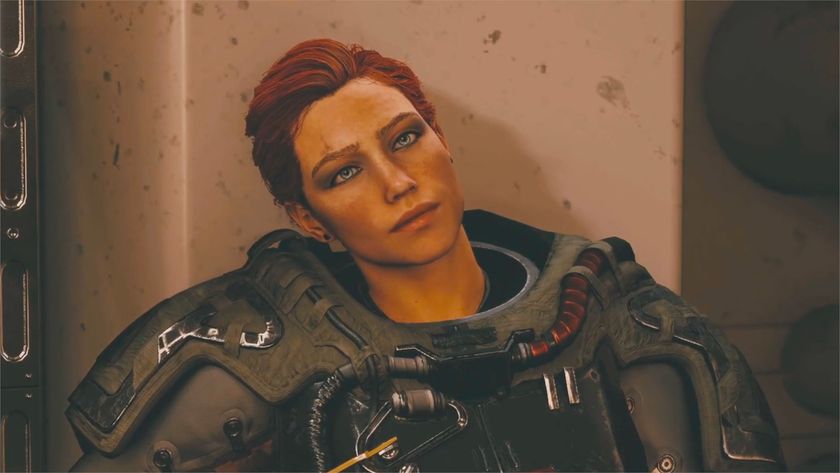Warframe: How Digital Extremes pulled a free-to-play shooter from the shadows
Warframe has been around since before the start of this console generation, but it isn’t how you remember it

Warframe was, in no uncertain terms, a risk. This was the passion project of Digital Extremes, a AA-tier developer that cut contract work to be able to self-publish a free-to-play game. “[When we started on Warframe], there were no expectations. Just the question of whether I'd have a job in six months," explains Rebecca Ford, Warframe's Live Ops and Community Director. But seven years later, Ford is still in work, having helped steer Warframe through tumultuous development to become a secret contender to the Destiny throne.
There wasn’t a lot to Warframe back when it first started. There were three of the titular Warframe classes in the open beta back in 2013, along with one tileset that would make up the game’s procedurally generated level layouts. Our own Warframe review at the time awarded it three stars, and there’s a chance many that downloaded it on their launch-day PS4 didn’t ever feel the urge to return.
Fast forward to March 2020 though, and the game has grown into one of this console generation’s unsung heroes. In a world where big-money publishers like EA are entering the games-as-a-service arena and faltering (remember Anthem?), Digital Extremes continues to push the boundaries of what Warframe is.
“We’re on Devstream 139, we’re on update #27.1.2. We have more than 40 Warframes available to play, and 1 million Twitch followers. All of that is still a surprise and a delight,” Ford explains.
Seven years of 'framing
Seven years for any live-service title is impressive, but it feels even more so for a free-to-play title. For the unfamiliar, Warframe is a totally free-to-play, third-person shooter where players team up to carve through enemies across the galaxy. You step into the shoes of the Tenno – essentially space ninjas – who work their way from planet to planet in ever-challenging battles. With 21 mission types, gameplay always feels varied, helped by its action focus that brings in weapons like guns, bows, swords, axes, and, of course, the titular Warframes themselves. These powerful suits of armour are, as the name would suggest, the stars of the show. Mixing HR Giger-esque organic aesthetics with industrial design, every Warframe is a marvel in itself, and each promotes an entirely fresh style of play.
But, the synopsis only tells part of the story, though. While the game may have begun with just a few mission types and a limited set of visual options, Warframe has expanded greatly over its seven year lifecycle, and it now offers plenty of planets to explore, aliens to slay, and materials to harvest.
In October 2017, the idea of what Warframe could be shifted entirely as Digital Extremes released The Plains of Eidolon. This open-world area is an entirely bespoke map, with flora, fauna, and even the ability to fish in one of its many bodies of water. With a new day/night cycle, the ability to switch loadouts on the fly, and a wealth of secrets buried in subterranean caves, The Plains of Eidolon felt like Warframe taking its next big step out of the shadows and into the limelight – literally as well as physically. You could look at the early game’s dingy, industrial corridors alongside an image of Plains of Eidolon and make an argument that they come from different titles.
Sign up to the 12DOVE Newsletter
Weekly digests, tales from the communities you love, and more

“Trying to make a little something for everyone is important, but our breakthroughs have always come in the form of establishing stakes in the world through quests and ‘wow moments’ in terms of the story”, says Ford.
Those ‘wow moments’ come thick and fast in the game’s recent Empyrean expansion, released in December 2019. Following on from the Plains of Eidolon’s expansive landmass, Empyrean adds space combat to Warframe, another entire gameplay system that seemed far-fetched all the way back in 2013.
These multiplayer missions require coordinating a ship’s movement with another player firing weapons, all while a ground attack takes place. It takes the best of the final third of ‘Return of the Jedi’, and caps it off with an explosive finale where players eliminate high-ranking targets. Just like the Plains of Eidolon, it feels like an entirely new game grafted onto what was already there.
That’s just as well, because for a game that sees new players arrive on a near-constant basis, as well as hardcore fans (Digital Extremes even hosts an annual TennoCon for the long-serving players), the balance has to be right between easily accessible content and meatier, more aspirational things for players to do. Leaning too much into either camp risks upsetting the balance of Warframe, and that balance hasn’t come easily.
“There are too many challenges to list. Every year gets harder, not easier – the challenges compound rather than resolve,” Ford explains, highlighting that the Plains of Eidolon aimed to satisfy all players equally.
“It takes place on Earth, which is in the beginning of the game, it’s easy to cruise around and get in fights and earn stuff, but you’ll need to log some hours to get an Archwing [Warframe’s method of transportation] and really take advantage of the expansion’s higher level rewards.”
“Among other things, we’ve learned that players love Cinematic Quests and the lore that progresses the story.”
It's this story and deep lore keeps players logging in, with many fans referring to a quest called The Second Dream as one of the game’s finest. It really highlights Digital Extremes’ attention to detail in the universe it has built while also putting the dense, underlying narrative front and centre.
But, it sounds like Digital Extremes is nowhere near done with the game's story, with Ford hinting that “the Corpus are about to enter the Spotlight in a very big way” – an event that's been some seven years in the making. For those wondering, the Corpus are essentially a black-market faction dealing in the sale of Warframes and their tech.
“A faction that we’ve known for seven years is on the cusp of some research that interests the entire Origin System. Stay tuned for The Deadlock Protocol.”
Watch and listen

But none of this evolution has been possible without the game's community. In January of this year, Digital Extremes published a spreadsheet detailing a wealth of player feedback it had received – both positive and negative – about the game. Many praised the Warframe's unique art style and kinetic combat, others criticised the onboarding process and requested more endgame-level content. Many just wanted to let the team know that they’re doing a great job. In fact, the entire document is available for players to read, with the team looking to its hungry player base to inform the direction of the game over the coming months.
“As we year-on-year build out Warframe, we’re also constantly looking at both new player onboarding and veteran player activity. We have a full stats team that looks at activity across the board. What have we learned? The list is so big, we could write a book!” Ford jokes. Looking at the spreadsheet, though, you wouldn’t be surprised.
“It’s about trying new things, learning from mistakes, and improving. Sometimes, the improvements come from internal development, but most of the time, we listen to our players and adjust”
“I think we’re lucky that our playerbase is the way that it is, and however they got that way has just been through seven years of us celebrating successes and working through failures together.”
The War(frame) to come

Warframe is currently available on PC, PS4, Xbox One and Nintendo Switch, but with the imminent jump to a new generation of consoles, will the game make the leap? Ford herself seems confident.
“It’s a loaded question, but it's also pretty straightforward. I do think it will be as simple as people playing the Warframe they know and love, just performing a lot better and looking a lot better by utilizing everything the hardware has to offer.”
Good news for fans then, but what about cross-progression? The arrival of the Nintendo Switch version did allow for players to import their data, but it was only a one-way move. Could we see the function return on a more permanent basis? Ford isn’t ruling anything out.
“I personally think this is so important for us, and I hope our dev team can pull this off.”
One thing is clear, Warframe’s team hasn’t lost enthusiasm for the game that seven years ago looked like a gamble, and neither has its fanbase.
Could we be celebrating another seven years in 2027? WIth the upcoming Deadlock Protocol reaping narrative seeds that were sown in 2013, you wouldn’t bet against it.
Lloyd Coombes is a journalist and copywriter on the video game and technology beat. Lloyd is proficient in writing reviews, previews, op-eds, and features, contributing all that and more to websites like 12DOVE and countless others. He also used to be a singer in pop-punk band Counties, although he's currently focused on his day job as the games editor over at Dexerto.

The Witcher 4 has "a huge team" focused on the believability of the RPG's world, because even things like trees and foliage always need to belong

Starfield could release on PS5 with a second expansion this year according to Xbox insiders, but it was reportedly originally meant to launch with Shattered Space











